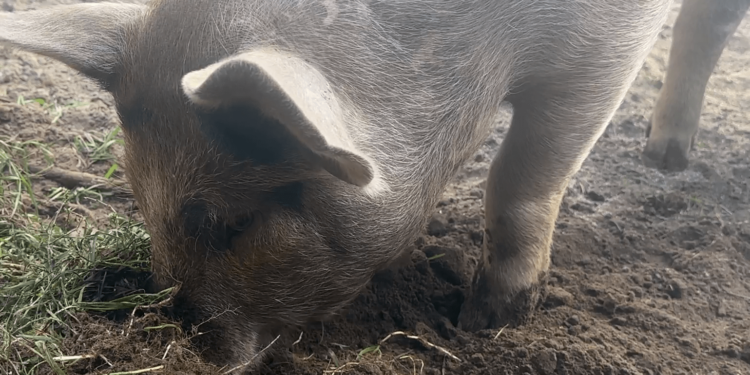KINGSFORD, Mich. (WZMQ) – The Florence County Conservationist, Scott Goodwin, has issued a grave warning as at least two farms in the area report severe crop damage, with reports circulating near Aurora and Commonwealth. Right now, the exact number of pigs that are causing the damage is unconfirmed, but estimates range anywhere from 5 to 20 hogs. Invasive species experts say even a small number of hogs can cause a sizable amount of damage. The USDA has placed a cell camera to monitor the activity of the culprit, but no movement has been confirmed from the USDA monitors so far. The damage is attributed to a feral pig group, as confirmed by the USDA, and a landowner.
Mary Lindow, a distressed landowner, shared her harrowing experience. “We have a 55-acre hayfield that they totally destroyed. So when we went out to do second crop hay, there was nothing there. I mean from the road it looked like, you know, you had green around the edges, it was green, so it looked good. But when we went out there to start cutting hay, it’s like – no, there’s nothing here; it’s all tore up,” Lidlow shared.
Lindow went on to confirm that the USDA had verified tracks, and scat left behind by the marauding hogs. Concerns are not limited to crop damage alone, as Scott Goodwin emphasized, “This is more than one or two individual pigs; this is probably a full group. In which case, we probably have a breeding population. Feral pigs do just fine up north in other areas.”
Lidlow echoed Goodwin’s concerns, recalling the destruction on her property. “There were big gouges in the ground; it was stuff that looked like it had been turned over. And we thought it was sandhill cranes,” she said, counting as many as 25-30 cranes on the property.
“But when we got the USDA guy to come out to check and see what we could do for that damage, he said, no, this isn’t cranes. Cranes don’t do this. He said you have hog damage. So he started investigating for hog damage. Eurasian boar hogs,” Lindow informed.
Goodwin related, “Their damage can appear as sandhill crane damage or damage from other wildlife. So that can be confusing.”
While legally, with a small game license, and landowner permission, the pigs can be hunted, conservationists fear that shooting them will cause the sounder to disperse and worsen the problem.
“So while we need hunters’ reports on seeing them, either in-person or on their trail cameras, it’s not ideal for them to shoot them if they are in a group right now,” Goodwin advised.
The land conservationist estimates between 10-20 wild pigs in the sounder, after having the summer to reproduce. He says the impact to the Upper Peninsula is significant with regard to the crop damage, and he says with the acorn drop right now they are finding feed elsewhere, but when they run out of acorns they will likely return to the farmer’s fields. The farmers are guessing the rooting is to feed on a layer of grubs just below the soil surface. But the conservationist is concerned over the detriment to the forest.
“Their rooting activity disrupts the forest ecology, and we will end up with a lower number of trees if this goes on. Because it is damaging seedlings, and that is an important aspect.” stated Goodwin.
“We have an opportunity to get rid of the problem early on, and reasonably cheaply. If we go one or two years, we’re going to be spending a whole lot of money, and a whole lot of effort and time, trying to take care of a problem that we may not ever solve,” he warned.
The farmer of one property estimated the damage to cost a minimum of $10,000 in seed and fertilizer, around another $1000 in fuel, and at least 12 hours of labor to work up the soil. The field produces a first cutting on a good year, approximately 1,000 large round bales of hay, and the second cutting loss puts the farm at least several hundred large round bales short on production, which is the farm’s source of income.
“If we don’t get them contained, we’ll be fighting this issue for years to come,” Goodwin informed. He is hopeful that with the public’s cooperation, and the help of the USDA, the sounder can be contained, but he also knows the sounder is more than capable of surviving a U.P. winter. The USDA has proposed bringing in a specialized team from Texas, as one viable option aimed at capturing and containing the swine.
WZMQ reached out to the Michigan Wildlife Services Office, who promised to provide more information tomorrow, as the director was currently busy with meetings and calls due to the possible government shutdown. Lindsay Peterson of the Wild Rivers Invasive Species Coalition office in Kingsford, is working to spread awareness of the issue, locally. She believes that right now, the sounder is mostly confined to Florence County, but she’s encouraging anyone that’s out hunting or baiting right now to be on the lookout for feral pigs in the area, and report those sightings as soon as possible to the Wisconsin DNR, or the Land Conservation Department.
For more information, or to report a sighting or trail camera capture, the following phone offices are taking calls:
USDA-WS: 1-866-487-3297
WI DNR: 608-266-2151
FC LCD 715-528-5940
Or visit: https://dnr.wisconsin.gov/topic/hunt/feralpig
*Photo Courtesy: Brampton Acres


















